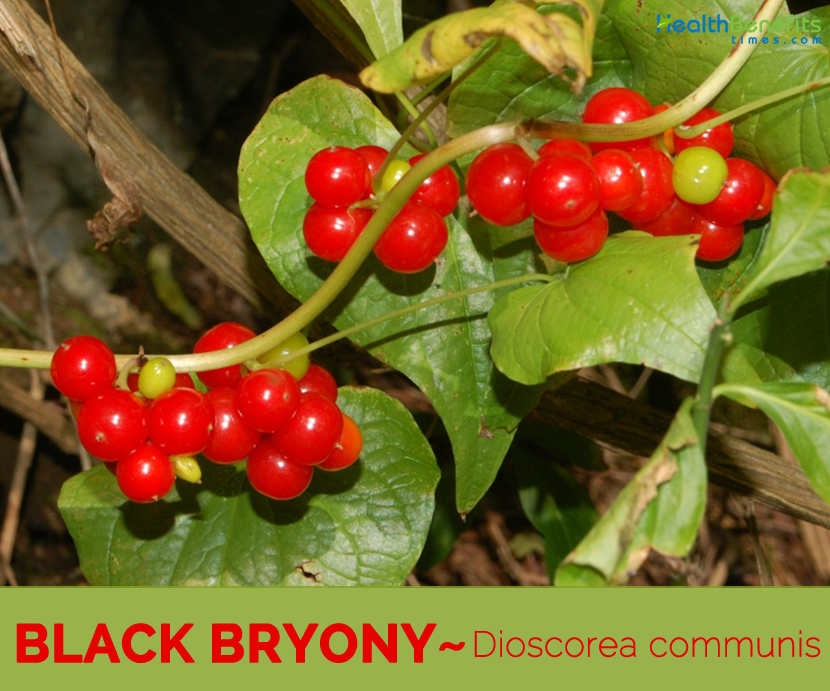| Black Bryony (Ladies Seal) Quick Facts | |
|---|---|
| Name: | Black Bryony (Ladies Seal) |
| Scientific Name: | Dioscorea communis |
| Origin | Southern and central Europe |
| Colors | Initially green, scarlet red when ripe |
| Shapes | Bright red berry, 1 cm diameter |
| Taste | Acrid |
| Health benefits | Remedy for asthmatic complaints, agitation and redness of the skin, bruises, strains, torn muscles, gout |
Plant Description
Black Bryony (Ladies Seal) is a climbing herbaceous plant that grows about 2–4m (6.5-13ft) tall. The plant is normally found growing in forest understory, from the sea to the mountains, usually in dense woods, but it can also be found in meadows and hedges. It prefers sandy, loamy and clay soils, requires well-drained soil and can grow in heavy clay soil. The plant also prefers acid, neutral and basic (alkaline) soils. The plant has a large, fleshy root that is almost cylindrical with a diameter of 2 to 3 cm. The root is 6 to 8 cm long and has scattered, thin root fibers. Externally, the root is blackish-brown. Internally, it is whitish and produces a slimy paste when it is peeled. Stem is very long, slender, angular or round, branched. Weak stems twins clockwise around anything within reach, climbing or creeping amongst trees, bushes and undergrowth. The stem dies back in winter but the root is perennial.
Leaves
Leaves are heart-shaped pointed 10cm long by 8cm wide (4in by 3in), with a petiole up to 5cm (2in) long, are smooth with a shiny appearance as if they have been varnished, turning dark purple or bright yellow, the stems die down in the winter.
Flower & Fruit
The flowers have a bell-shaped perianth, and are small, yellowish-green, and regular, in axillary racemes on long stalks. The plant is dioecious. The male flowers are solitary or grouped in slender racemes, branched at the base, with 6 stamens inserted on the base of the perianth-segments. The female flowers are in shorter racemes, bent back, few-flowered, with a perianth adhering to the ovary, and short functionless stamens. The bracts are very small. The limb of the perianth is 5-partite. There is a single style. Flowers are found on various plants in fertile and infertile form. The fertile flowers develop into crimson berries. Berries are initially green and are scarlet red when ripe. The berry is oblong, few-seeded, and imperfectly 3-celled. Each berry contains (3) 6 globose seeds of red-brick or brownish color.
- It is not typically used internally; however, it has been used as a poultice for bruises and inflamed joints.
- The root is anti-ecchymotic, diuretic, emetic, haemolytic and rubefacient.
- It is not normally used internally, but the softened root is applied externally as a poultice to bruises, rheumatic joints etc.
- The expressed juice of the fresh root, mixed with a little white wine, has been used as a remedy for gravel, being a powerful diuretic.
- The expressed juice of the root, with honey, has also been used as a remedy for asthmatic complaints.
- Tincture made from the root proves a most useful application to unbroken chilblains, and also the fruits, steeped in gin, are used for the same remedy.
- Black Bryony is a popular remedy for removing discoloration caused by bruises and black eyes, etc.
- The plant is used for agitation and redness of the skin, bruises, strains, torn muscles, gout and other rheumatic disorders.
- Black Bryony is also used for irritation of the intestine mucous membrane and as an emetic.
- It is also used as a tonic for hair loss, as it improves blood circulation to the scalp.
Culinary Uses
- Young shoots are edible and can be used as asparagus substitute, and are usually picked in spring.
- Young shoots may be eaten raw, but they are usually cooked in hot water for various salads or used in omelet.
Precautions
- It has been recommended that black bryony be used topically with caution, due to a tendency for the plant to cause painful blisters.
- The whole plant is poisonous due to its saponin content.
- Children should be cautioned against eating them.
- Gloves should be worn to protect the hands, as the fresh roots cause serious reddening of the skin.
- Skin contact with the fresh plant leads to the formation of rashes, swelling, pustules and wheals, due to the skin- and mucous membrane-irritating oxalate needles and histamine.
- Internal administration triggers signs of severe irritation in the mouth, pharyngeal space and gastrointestinal tract, combined with vomiting and intense diarrhea.
- It should be avoided by pregnant and breast feeding women in any forms.
References:
https://www.pfaf.org/USER/Plant.aspx?LatinName=Tamus+communis
http://www.theplantlist.org/tpl/record/kew-239990
https://en.wikipedia.org/wiki/Dioscorea_communis
http://enacademic.com/dic.nsf/enwiki/11645436
https://www.botanical.com/botanical/mgmh/b/brybla75.html
http://www.brickfieldspark.org/data/blackbryony.htm
https://npgsweb.ars-grin.gov/gringlobal/taxonomydetail.aspx?423869
Comments
comments
